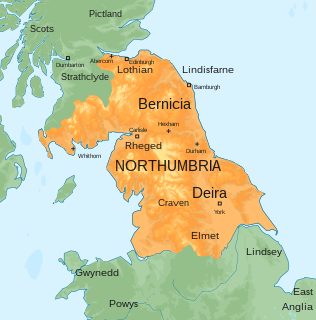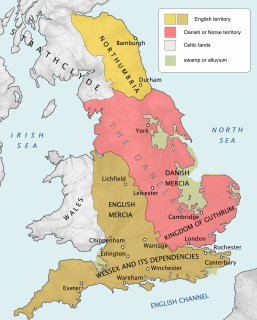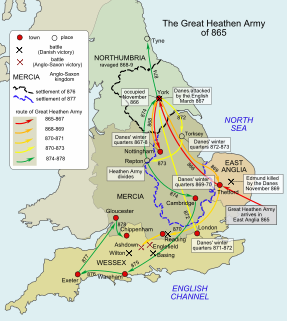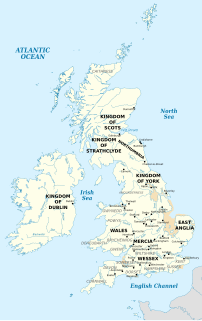Related Research Articles
Causantín or Constantín mac Cináeda was a king of the Picts. He is often known as Constantine I in reference to his place in modern lists of kings of Scots, but contemporary sources described Causantín only as a Pictish king. A son of Cináed mac Ailpín, he succeeded his uncle Domnall mac Ailpín as Pictish king following the latter's death on 13 April 862. It is likely that Causantín's reign witnessed increased activity by Vikings, based in Ireland, Northumbria and northern Britain. He died fighting one such invasion.

Northumbria was an early medieval Anglo-Saxon kingdom in what is now Northern England and south-east Scotland.

Æthelred I was King of Wessex from 865 until his death in 871. He was the fourth of five sons of King Æthelwulf of Wessex, four of whom in turn became king. Æthelred succeeded his elder brother Æthelberht and was followed by his youngest brother, Alfred the Great. Æthelred had two sons, Æthelhelm and Æthelwold, who were passed over for the kingship on their father's death because they were still infants. Alfred was succeeded by his son, Edward the Elder, and Æthelwold unsuccessfully disputed the throne with him.

Æthelflæd, Lady of the Mercians ruled Mercia in the English Midlands from 911 until her death. She was the eldest daughter of Alfred the Great, king of the Anglo-Saxon kingdom of Wessex, and his wife Ealhswith.

Year 910 (CMX) was a common year starting on Monday of the Julian calendar.

The Danelaw was the part of England in which the laws of the Danes held sway and dominated those of the Anglo-Saxons. The Danelaw contrasts with the West Saxon law and the Mercian law. The term is first recorded in the early 11th century as Dena lage. The areas that constituted the Danelaw lie in northern and eastern England, long occupied by Danes and other Norsemen.
Guthrum was King of East Anglia in the late 9th century. Originally a native of what is now Denmark, he was one of the leaders of the "Great Summer Army" that arrived in Reading during April 871 to join forces with the Great Heathen Army, whose intentions were to conquer the kingdoms of Anglo-Saxon England. The combined armies were successful in conquering the kingdoms of East Anglia, Mercia, and Northumbria, and overran Alfred the Great's Wessex, but were ultimately defeated by Alfred at the Battle of Edington in 878. The Danes retreated to their stronghold, where Alfred laid siege and eventually Guthrum surrendered.

Æthelwold or Æthelwald was the younger of two known sons of Æthelred I, King of Wessex from 865 to 871. Æthelwold and his brother Æthelhelm were still infants when their father the king died while fighting a Danish Viking invasion. The throne passed to the king's younger brother Alfred the Great, who carried on the war against the Vikings and won a crucial victory at the Battle of Edington in 878.

Halfdan Ragnarsson was a Viking leader and a commander of the Great Heathen Army which invaded the Anglo-Saxon kingdoms of England, starting in 865.
The Battle of Tettenhall took place, according to the Anglo-Saxon Chronicle, near Tettenhall on 5 August 910. The allied forces of Mercia and Wessex met an army of Northumbrian Vikings in Mercia.

The Great Heathen Army, also known as the Viking Great Army, was a coalition of Scandinavian warriors who invaded England in 865 AD. Since the late 8th century, the Vikings had been engaging in raids on centres of wealth, such as monasteries. The Great Heathen Army was much larger and aimed to occupy and conquer the four kingdoms of East Anglia, Northumbria, Mercia and Wessex.

Edward the Elder was King of the Anglo-Saxons from 899 until his death in 924. He was the elder son of Alfred the Great and his wife Ealhswith. When Edward succeeded to the throne, he had to defeat a challenge from his cousin Æthelwold, who had a strong claim to the throne as the son of Alfred's elder brother and predecessor, Æthelred.
Events from the 10th century in the Kingdom of England.

Æthelwold's Revolt was an attempt by Æthelwold ætheling to seize the Anglo-Saxon throne from Edward the Elder after the death of Alfred the Great in 899. It ended when Æthelwold was killed in battle in 902 while fighting alongside his Danish allies.

The Kingdom of the East Angles, today known as the Kingdom of East Anglia, was a small independent kingdom of the Angles comprising what are now the English counties of Norfolk and Suffolk and perhaps the eastern part of the Fens. The kingdom formed in the 6th century in the wake of the Anglo-Saxon settlement of Britain. It was ruled by the Wuffingas dynasty in the 7th and 8th centuries, but fell to Mercia in 794, and was conquered by the Danes in 869, to form part of the Danelaw. It was conquered by Edward the Elder and incorporated into the Kingdom of England in 918.
Events from the 9th century in England.

Viking activity in the British Isles occurred during the Early Middle Ages, the 8th to the 11th centuries, when Norsemen from Scandinavia travelled to Great Britain and Ireland to settle, trade or raid. Those who came to the British Isles have been generally referred to as Vikings, but some scholars debate whether the term Viking represented all Norse settlers or just those who raided.

The Pagan Lord is the seventh historical novel in the Saxon Stories by Bernard Cornwell, first published in 2013. The story is set in the early 10th century in Anglo-Saxon Mercia and Northumbria.
Airdeconut was a Norse King of Northumbria. Numismatic evidence suggests he was a Christian and he probably ruled in Northern England around the year 900.
Ingwær was a Norse King of Northumbria. According to Æthelweard's Chronicon he was a co-king of Northumbria along with his brothers Eowils and Halfdan, though the Anglo-Saxon Chronicle does not mention him. By Æthelweard's account he died at the Battle of Tettenhall alongside his brothers in 910.
References
- ↑ Downham, Clare (2007). Viking Kings of Britain and Ireland: The dynasty of Ívarr to A.D. 1014. Edinburgh, UK: Dunedin. pp. 80–81, 86. ISBN 978-1-906716-06-6.
- ↑ Downham, p. 87